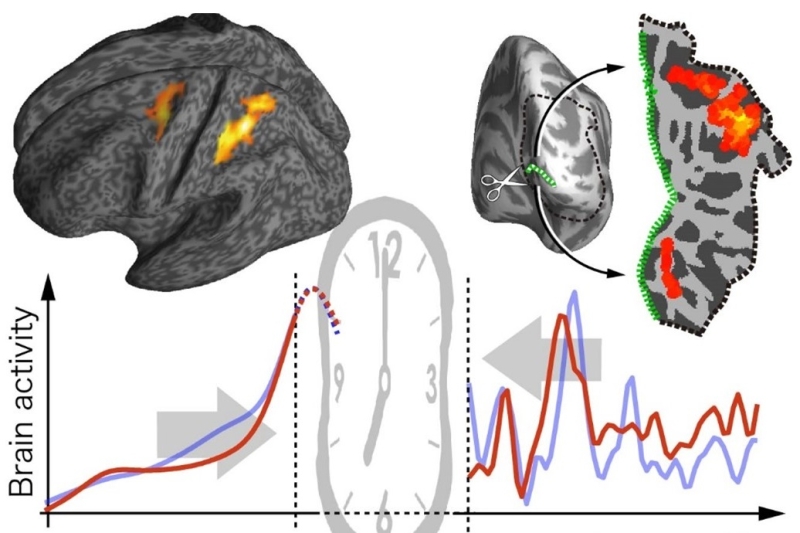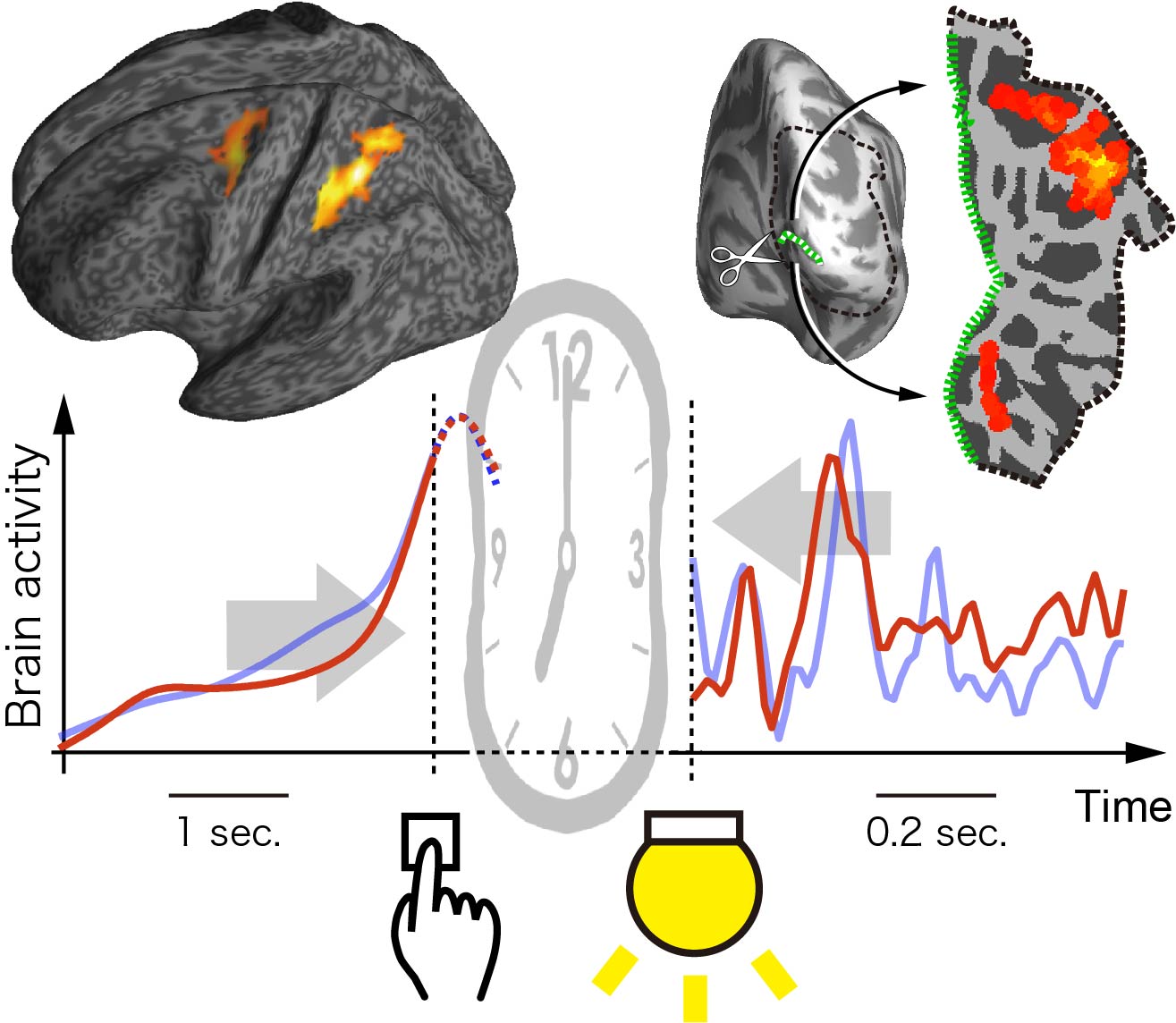Time shifts in our brain Psychological compression of time interval between action and its outcome


Brain mechanisms underlying time compression between action and its outcome
The left figures show changes in brain activity related to preparation of action (turning on a switch). The upper left figure indicates brain regions (orange-yellow) where temporal changes were observed before the action in correspondence to the psychological compression of time. The lower left figure shows details of the temporal changes: The red curve indicates brain activity when the psychological time compression occurred, and the blue curve indicates activity when the compression did not occur. This figure suggests that the activity related to the movement-preparation is delayed when the compression occurs. The right figures show brain activity evoked by the outcome (light turning on) of the action. The upper right figure indicates regions (red-yellow) where the temporal changes were observed within the visual areas at the back of the head. The lower right figure shows details of the temporal changes within the above regions. The activity related to perception of the action outcome proceeded (shifted from the blue to the red curve) when the compression occurred.
© 2018 Chang Cai and Hiroshi Imamizu.
Researchers at the University of Tokyo and their collaborators have determined the brain activity corresponding to our perception that the time interval between one’s own action and its outcome is shorter than it actually is. This finding reveals for the first time that changes in the timing of brain activity corresponds to changes in psychological time.
The time interval from when you flick the switch to when the light goes on in a room can be considered more or less constant. In a familiar room such as our own, we hardly perceive such constant time intervals, which we’ve experienced many times. However, in a room we’re entering for the first time, we perceive the interval distinctly, even if it is in fact the same as that in our room. We also perceive the interval as being shorter when we turn on the switch on our own volition rather than when forced to do so by someone else. These effects that our adaptation to a temporal delay or that our intention has on making our perceived interval seem shorter than it actually is are well-known phenomena in psychology. However, scientists know very little about how our brain activity changes when such time-interval compression occurs in our mind.
A research group led by Professor Hiroshi Imamizu at the Graduate School of Humanities and Sociology at the University of Tokyo investigated brain activity corresponding to this psychological phenomenon by using both magnetoencephalography, to attain a high temporal resolution, and functional magnetic resonance imaging, to achieve a high spatial resolution. The group found that, although the timing of turning on the light switch did not change, the readiness potential, or the brain activity tied to action preparation, was temporally delayed when the perceived interval appeared shorter than the actual one. Moreover, the researchers found that, conversely, the timing of the visually evoked potential, the brain activity summoned when turning on of the light, got pushed forward. This suggests that the timing of brain activity related to preparing an action and activity related to perceiving the action’s outcome shift as if by attracting each other, and that such shifts of brain activity cause psychological time compression.
The psychological time interval between an action and its outcome affects the sense of control for operating many devices. Impairments in the brain mechanism binding action with its outcome are known to cause a kind of hallucination in psychiatric disorders. The current study’s results are expected to contribute not only toward developing devices giving users a satisfactory feeling of control, but also elucidating neural mechanisms that recognize a relationship between the self and the external environment.
"There remain a lot of phenomena that are well known in psychology but whose neural mechanisms are unknown in brain sciences," says Imamizu. He continues, "By bridging psychology and brain sciences, we will elucidate enigmas of the mind-brain relationship."
This research was carried out in collaboration with Technical Researcher Chang Cai and Researcher Takanori Kochiyama at the Advanced Telecommunications Research Institute International (ATR), Associate Professor Kenji Ogawa at Hokkaido University, and Associate Professor Hirokazu Tanaka at the Japan Advanced Institute of Science and Technology (JAIST).
Papers
Chang Cai, Kenji Ogawa, Takanori Kochiyama, Hirokazu Tanaka, and Hiroshi Imamizu, "Temporal recalibration of motor and visual potentials in lag adaptation in voluntary movement," NeuroImage Online edition: February 8, 2018, doi:10.1016/j.neuroimage.2018.02.015.
Link (Publication )
)
Related links
- Graduate School of Humanities and Sociology

- Department of Psychology, Division of General Culture, Graduate School of Humanities and Sociology

- Imamizu Laboratory for Learning Mechanisms, Department of Psychology, Division of General Culture, Graduate School of Humanities and Sociology

- Advanced Telecommunications Research Institute International

- Laboratory of Kenji Ogawa, Department of Psychology, Graduate School of Letters, Hokkaido University

- Laboratory of Hirokazu Tanaka, Computational Neuroscience Laboratory, School of Information Science, Japan Advanced Institute of Science and Technology

- Grant-in-Aid for Scientific Research on Innovative Areas “Understanding brain plasticity to promote their adaptive functions”






